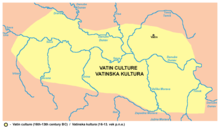 | |
| Period | Bronze Age |
|---|---|
| Dates | c. 2000 – 1500 BC/13th century BC |
| Type site | Vatin |
| Characteristics |
|
| Preceded by | Somogyvár-Vinkovci culture, Nagyrév culture, Vučedol culture |
| Followed by | Encrusted Pottery culture, Belegiš culture, Urnfield culture, Glasinac-Mati culture |
The Vatin culture (Serbian: Ватинска култура, Vatinska kultura or Ватинска група, Vatinska grupa) is a name of a prehistoric Bronze Age culture, which was named after Vatin, a village in Serbia. The culture had Indo-European roots and was culturally connected with Mycenaean Greece.[1] The Vatin culture is dated to the middle Bronze Age and is generally divided into three phases: Pančevo-Omoljica, Vatin-Vršac, and Belegiš-Ilandža.[2] It flourished from c. 2000 BC to 1500 BC,[3] or until the 13th century BC according to some sources.[4]
The people of the Vatin culture inhabited the entire territory of Vojvodina (Banat, Bačka, Syrmia) and many surrounding areas (including Slavonia, Oltenia, Bosnia and Central Serbia). Its core area was in Serbian-Vojvodinian Podunavlje.[2] The remains of this culture were discovered at the beginning of the 20th century near the village of Vatin (Banat region, Vojvodina province, Serbia). However the real importance of this culture was only realised at the end of the 20th century, when the locality of Feudvar near the village of Mošorin was investigated.
- ^ "Archived copy" (PDF). Archived from the original (PDF) on 2012-04-25. Retrieved 2011-11-03.
{{cite web}}: CS1 maint: archived copy as title (link) - ^ a b "brončano doba - skripta". Scribd.com. Retrieved 29 April 2019.
- ^ Molloy, Barry; et al. (2023). "Resilience, innovation and collapse of settlement networks in later Bronze Age Europe: New survey data from the southern Carpathian Basin". PLOS ONE. 18 (11): e0288750. Bibcode:2023PLoSO..1888750M. doi:10.1371/journal.pone.0288750. PMC 10637690. PMID 37948415.
- ^ "[Projekat Rastko] Dragoslav Srejovic: Kad smo bili kulturno srediste svetaКад смо били културно средиште света". Rastko.rs. Retrieved 29 April 2019.